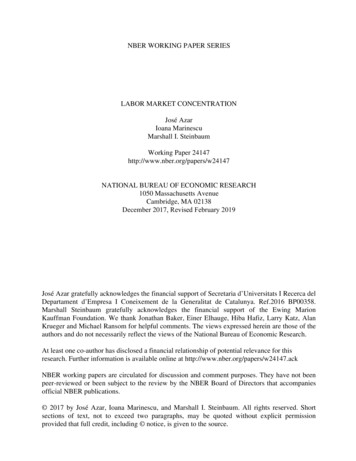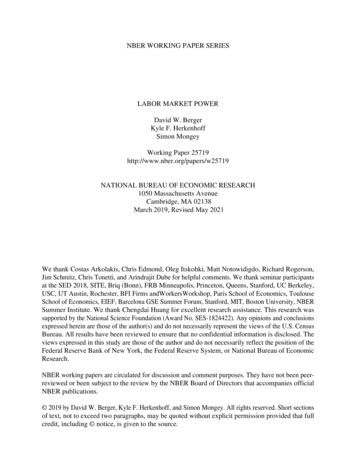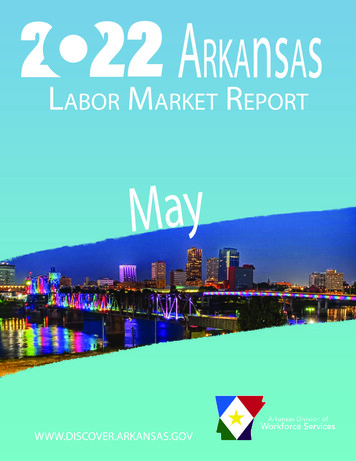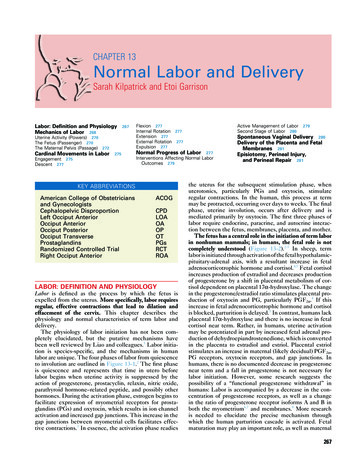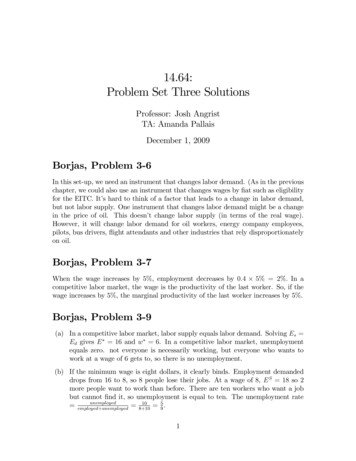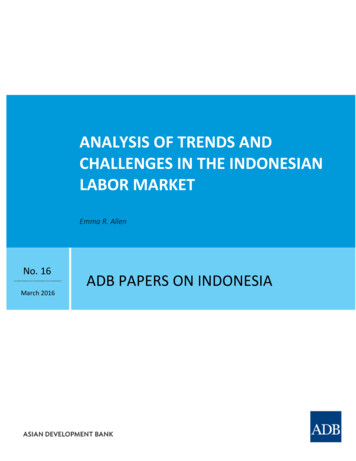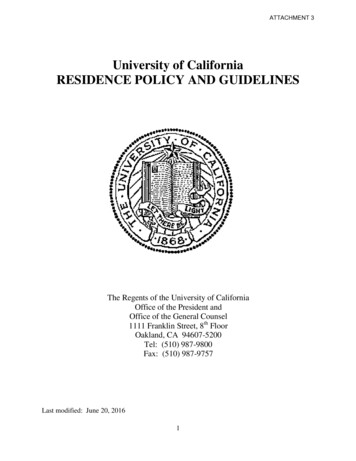
Transcription
California’s Labor Market inthe Time of COVID-192021 ChartbookEnrique Lopezlira, Kuochih Huang, Sarah Thomason,Annette Bernhardt, and Ken JacobsLast Updated: July 28, 2021
Section 1:California had extraordinary job loss,and hasn’t yet fully recovered
California’s economy experienced massive job losses from thepandemic, and it is still a long way from fully recovering. Compared to the nation as a whole, California lost a greater proportion of jobs during thepandemic. As of June 2021, the state has recovered over half of these job losses. The pandemic affected the entire state’s economy, but job losses were concentrated inservice industries that had to shut down (e.g., restaurants and entertainmentestablishments) and schools. These industries account for most of the recent job gains,but they are still far from full recovery. Industries that typically pay low wages were hardest hit by the pandemic. As the marketrecovers, these jobs are returning much more slowly than jobs in industries paying highwages. While private employment is beginning to recover, public sector employment is largelystagnant, especially for local governments.
Percentage Change in Employment: US vs California,February 2020 to June 2021Source: Authors’ analysis of the Current Employment Statistics. Data is non-farm employment and is not seasonally adjusted.
California’s Progress Towards EmploymentRecovery by Industry, June 2021Source: Authors' analysis of Current Employment Statistics. Data is not seasonally adjusted.Note: Recovery is measured as the number of jobs gained by June 2021. Since the trajectory of employment losses differs by industry, the month of lowest employment levels also varies by industry.
Percentage Change in Number of Private Sector Jobs in California,February 2020 to June 2021Source: Authors' analysis of the Current Employment Statistics and the Quarterly Census of Employment and Wages. Data is not seasonally adjusted.
California's Employment: Private vs Public Sector,February 2020 to May 2021Source: Authors’ analysis of the Current Employment Statistics. Data is monthly, and is seasonally adjusted. May numbers are preliminary.
Section 2:Job losses affected the full gamut ofworkers, but some groups wereaffected more than others
Job losses from the pandemic were widespread, but some groups ofworkers were more severely impacted. These same workers are alsostruggling to regain jobs as the economy recovers. Prior to the onset of COVID-19, the unemployment rate in California was slightly higher thanthe national rate, but this gap widened during the pandemic, reflecting the severe effect of thecrisis on the state’s economy. The current 8 percent unemployment rate is still significantlyhigher than the pre-pandemic rate. The lowest paid workers accounted for a full 80 percent of all jobs lost nationally. Whileemployment for high-wage workers is stronger now than prior to the pandemic, significant jobloss persists for workers earning below the median wage. Educational attainment contributed to large differences in the severity of the pandemic’simpact across workers. Workers with a high school diploma or less experienced a much higherincrease in unemployment at the peak of the pandemic. Women faced much larger increases in unemployment than men. While the unemploymentrate for women has now fallen below that of men, this is largely due to women exiting the labormarket.
Job losses from the pandemic were widespread, but some groups ofworkers were more severely impacted - CONTINUED Black and Latino workers faced higher unemployment rates prior to COVID-19, and this gapwidened significantly at the peak of the pandemic. As the jobless rate for other workersimproves, the unemployment rate for Black workers remains high and more than twice therate of non-Latino White workers. Immigrant women experienced significant and disproportionate job loss during the initialmonths of the pandemic, reflecting the overrepresentation of these workers in serviceindustries that shuttered during the crisis. As people return to work, the overall number of unemployed has come down, but,increasingly, most of those who remain unemployed are workers who have been out of workfor six months or longer. As we will see in Section 3, the decline in unemployment is due inpart to workers dropping out of the labor market altogether, as opposed to increasingnumbers of jobs.
Unemployment Rate: California vs US,January 2020 to June 2021Source: Authors’ analysis of the Current Population Survey, and the Local Area Unemployment Statistics. Data is not seasonally adjusted.
Percentage Change in California Employment byWage Level, February 2020 to May 2021Note: Data sources include Earnin, Intuit, Kronos, and Paychex, provided by Opportunity Insights Economic Tracker.
California's Unemployment Rate by Gender,January 2020 to June 2021Source: Authors’ analysis of the Current Population Survey. Data is not seasonally adjusted. Horizontal axis shows a three-month average (e.g., Jan 2021 refers to Nov 2020–Jan 2021).
California’s Unemployment Rate by Education,January 2020 to June 2021Source: Authors’ analysis of the Current Population Survey. Data is not seasonally adjusted.Note: Unemployment rates are calculated for persons 25 years and older by educational attainment. Values show a three-month average (e.g., Jan 2021 refers to Nov 2020–Jan 2021).
California's Unemployment Rate by Race and Ethnicity,January 2020 to June 2021Source: Authors’ analysis of the Current Population Survey. Data is not seasonally adjusted.Note: Black, Asian, and White workers are non-Latino. Latino workers can be of any race. Horizontal axis shows a three-month average (e.g., Jan 2021 refers to Nov 2020–Jan 2021).
California’s Unemployment Rate by Gender and Nativity,January 2020 to June 2021Source: Authors’ analysis of the Current Population Survey. Data is not seasonally adjusted. Values show a three-month average (e.g., Jan 2021 refers to Nov 2020–Jan 2021).
Long-Term Unemployed Workers vs Total Unemployed Workers inCalifornia, January 2020 to June 2021Source: Authors’ analysis of the Current Population Survey. Data is not seasonally adjusted.Note: Values show a three-month average (e.g., Jan 2021 refers to Nov 2020–Jan 2021). Long term unemployment is defined as being unemployed for 27 weeks or longer.
Undocumented Workers We currently have little comprehensive information about the impact of the COVID-19pandemic on undocumented workers. California has more than two million undocumented people, over 100,000 of whom workedas essential workers during the COVID-19 pandemic, while many others facedunemployment. Studies estimate that between 357,000 and 500,000 immigrants withoutlegal status in the state found themselves out of work during the pandemic. The consequences of unemployment are especially severe for undocumented workersbecause of their inability to access most safety net programs. (California’s Disaster ReliefAssistance for Immigrants program provided one-time stimulus payments to only about150,000 undocumented immigrants and their families in the spring of 2020.) As part ofCalifornia’s 2021-22 budget, some undocumented workers are eligible to receive anadditional one-time 500 stimulus payment.
Occupational Segregation Many of the adverse employment trends from the pandemic are the result of widespreadoverrepresentation of women and Black and Latino workers in the most affectedindustries, in both California and the US. This is known as occupational segregation. The pandemic has shown that people of color, women, and immigrants are more likely tobe in essential jobs that pose increased economic and health risks to these workers. The forces that drive occupational segregation range from outright discrimination, legaciesof decades of discriminatory employment policies, and current social and economic factorsshaping career choices (that themselves represent institutionalized racism, sexism, andnativism), affecting a wide range of job quality and career outcomes.
Section 3:Unemployment is not the only story
Unemployment is not the only story. Many workers left the labormarket altogether. As the pandemic began, large numbers of Californians left the workforce, and the share ofthe population either working or looking for work in California decreased substantiallycompared to the US as a whole. Most workers that left the labor force were the least educated (high school or less). Manyof these workers remain on the sidelines, even as labor market conditions improve. Women in general shouldered the brunt of the economic crisis from COVID-19. The shareof women in California who are working declined more than men during the first sixmonths of the pandemic. As the economy began to open back up, women’s share of theworking population has improved more than men’s.
Unemployment is not the only story - CONTINUED Although both men and women have seen improvements in recent months, the workingshare of the population remains below the pre-crisis level irrespective of gender. Black and Latino workers overall saw a significant decrease in their share of thepopulation with a job. While Latino workers are beginning to recover, the economy is stillnot adequately providing jobs for Black workers.
Share of the Population Working or Looking for Work:California vs US, January 2020 to May 2021Source: Authors’ analysis of the Current Population Survey, and the Local Area Unemployment Statistics. Population refers to people ages 16 and up. Data is not seasonally adjusted.
California's Share of the Population Working or Looking for Work,by Education, January 2020 to June 2021Source: Authors’ analysis of the Current Population Survey. Population refers to people ages 16 and up. Data not seasonally adjusted.Note: Horizontal axis shows a three-month average (e.g., Jan 2021 refers to Nov 2020–Jan 2021).
California’s Share of the Prime Age Population Currently Employed,January 2020 to June 2021Source: Authors’ analysis of the civilian non-institutional population 24 to 54 years old in the Current Population Survey. Data is not seasonally adjusted.Note: Horizontal axis shows a three-month average (e.g., Jan 2021 refers to Nov 2020–Jan 2021).
California’s Share of the Prime Age Population Currently Employedby Race and Ethnicity, January 2020 to June 2021Source: Authors’ analysis of the civilian non-institutional population 24 to 54 years old in the Current Population Survey. Data is not seasonally adjusted.Note: Black, Asian, and White workers are non-Latino. Latino workers can be of any race. Values show a three-month average (e.g., Jan 2021 refers to Nov 2020–Jan 2021).
The Caregiving Crisis COVID-19 worsened a caregiving crisis that preceded the pandemic. As schools anddaycare centers were forced to close, women shouldered the bulk of the additionalresponsibilities of caring for children. These added responsibilities forced millions ofwomen to exit the labor force nationally due to inadequate resources to help balance thedemands of a full-time job and virtual schooling of their children. Women not only had to contend with increased childcare responsibilities while working,but possibly also had to provide long-term care to elderly parents or other relatives withdisabilities. As California begins to fully reopen, there are tens of thousands of women workers on thesidelines unable to re-enter the workforce. This comes at a great economic cost, not onlyto the workers themselves, but to California’s overall economy.
Section 4:The impacts of the COVID-19 recessionweren’t just on employment
The impact of COVID-19 was not limited to the labor market. While the economy is starting to recover, many workers, especially workers of color andlow-wage workers, continue to experience a high level of economic insecurity. Nearly half of households earning less than 50,000 per year report difficulty paying usualhousehold expenses as a result of the pandemic. One in five households earning less than 50,000 per year report not getting enough toeat in the past week. One in five Black renters and one in seven Latino renters are behind on rent payments. One-third of households earning less than 50,000 per year report delaying medical caredue to the pandemic.
Proportion of Working California Households Reporting DifficultyCovering Household Expenses, May/June 2021Source: Authors’ analysis of US Census Household Pulse Survey Week 31 (May 26 - June 7, 2021)
Proportion of Working California Households That ReportNot Having Enough to Eat in the Last Week, May/June 2021Source: Authors’ analysis of US Census Household Pulse Survey Week 31 (May 26 - June 7, 2021)
Proportion of Renter California Households Behindon Rent Payments, May/June 2021Source: Authors’ analysis of US Census Household Pulse Survey Week 31 (May 26 - June 7, 2021)
Proportion of Working California Households Who Report DelayingMedical Care Due to the Pandemic, May/June 2021Source: Authors’ analysis of US Census Household Pulse Survey Week 31 (May 26 - June 7, 2021)
Section 5:Looking ahead
Economic Forecasts for California A 2020 forecast by UCLA’s Anderson School of Management predicts the economy inCalifornia to grow 5 percent on average in 2021 and 2022. Its 2021 forecast predicts astate unemployment rate of 6 percent over the next two years, still higher than it waspre-pandemic. The California State Department of Finance also expects the unemployment rate toaverage 6 percent in 2021 and 2020. Both forecasts predict that it will take several years for the labor market in California tofully recover from the COVID-19 shock.
Questions About the Post-Pandemic EconomyEven as the recovery continues, critical questions remain: What jobs will return and grow after the pandemic? What industries will be permanentlychanged? What will be the quality of jobs in the post-pandemic economy? How much of the workforce has permanently left the labor market? What will the economic recovery look like for undocumented workers, who do not haveaccess to the resources and assistance available to other workers? What will the be the long-term impact to the economy from productivity losses due toeducation, health, and labor effects from the pandemic?
END
Assistance for Immigrants program provided one-time stimulus payments to only about 150,000 undocumented immigrants and their families in the spring of 2020.) As part of California's 2021-22 budget, some undocumented workers are eligible to receive an additional one-time 500 stimulus payment. Undocumented Workers

